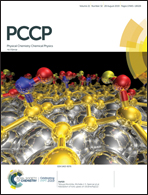Spin-pair state-induced exceptional magnetic field responses from a thermally activated delayed fluorescence-assisted fluorescent material doping system†
Abstract
The thermally activated delayed fluorescence (TADF) material 2,3,5,6-tetrakis(3,6-diphenylcarbazol-9-yl)-1,4-dicyanobenzene (4CzTPN-Ph) and the conventional fluorescent dopant 4-(dicyanomethylene)-2-tert-butyl-6-(1,1,7,7-tetramethyljulolidin-4-yl-vinyl)-4H-pyran (DCJTB) were used to co-dope the host material 4,4′-bis(carbazol-9-yl)biphenyl (CBP) for the fabrication of TADF-assisted fluorescent organic light-emitting diodes (OLEDs). Some exceptional magnetic field effect (MFE) curves with abundant structures and four tunable components within a low magnetic field range (≤50 mT) were obtained, in sharp contrast to the maximum of two components observed in typical OLEDs. These MFE components were easily tuned by the injection current, dopant concentration, working temperature, and dopant energy gap, leading to a wide variety of MFE curve line shapes. The experimental results are attributed to the spin-pair state inter-conversions occurring in the device, including intersystem crossing (ISC) of CBP polaron pairs, ISC of 4CzTPN-Ph polaron pairs, reverse ISC (RISC) of 4CzTPN-Ph excitons, RISC of DCJTB polaron pairs, DCJTB triplet fusion, and DCJTB triplet-charge annihilation. Moreover, the exciton energy transfer processes among the host material and the guest dopants had a pronounced impact on the formation of these four components. This work gives a deeper understanding of the microscopic mechanisms of TADF-based co-doped systems for the further development of organic magnetic field effects in the extensive field of OLEDs.



 Please wait while we load your content...
Please wait while we load your content...